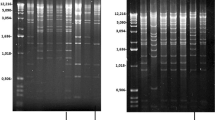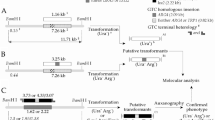Abstract
The switching of mating-type genes in both homothallic and heterothallic strains of the yeast Saccharomyces cerevisiae involves a site-specific transposition event1–3. A sequence at the mating-type locus (MAT) is replaced by a copy of a or α information from the unexpressed, loci, HML or HMR. Although MATa and MATα contain unique sequences of ∼700 base pairs (bp), they are flanked by sequences that are also found at HML and HMR4,5 (Fig. 1a). Recent results6–8 have suggested that the switching of MAT alleles involves an intrachromosomal mitotic gene conversion event, in which a donor sequence at HML or HMR pairs with the homologous sequences at the MAT locus. On this view the switching of mating-type information must be able to accommodate the region of non-homology in a heteroduplex structure. (Analogous gene conversions of non-homologous regions have been well documented during meiosis at MAT and for deletions in other yeast genes9,10.) One prediction of a gene conversion mechanism is that it should be possible to transpose a tandem duplication of mating-type genes from HMR to MAT. In such a switch, pairing would occur between MAT and homologous sequences flanking the two copies of the tandem duplication at HMR. Our results reported here demonstrate that a tandem duplication created at HMR by recombinant DNA techniques can be transposed to MAT without the loss of these sequences at the donor locus.
Similar content being viewed by others
References
Oshima, Y. & Takano, I. Genetics 67, 327–335 (1971).
Hicks, J. B., Strathern, J. N. & Herskowitz, I. DNA Insertion Elements, Plasmids and Episomes (eds Bukhari, A., Shapiro, J. & Adhya, S.) 457–462 (Cold Spring Harbor Laboratory, New York, 1977).
Hicks, J., Strathern, J. & Klar, A. J. S. Nature 282, 478–483 (1979).
Nasmyth, K. & Tatchell, K. Cell 19, 753–764 (1980).
Strathern, J. N., Spatola, E., McGill, C. & Hicks, J. B. Proc. natn. Acad. Sci. U.S.A. 77, 2839–2843 (1980).
Haber, J. E., Rogers, D. T. & McCusker, J. H. Cell 22, 277–289 (1980).
Klar, A. J. S., Mclndoo, J., Strathern, J. N. & Hicks, J. B. Cell 22, 291–298 (1980).
Haber, J. E., Rowe, L. & Rogers, D. Molec. cell. Biol. 1, 1106–1119 (1981).
Klar, A. J. S., Fogel, S. & Lusnak, K. Genetics 92, 777–782 (1979).
Fink, G. R. & Styles, C. A. Genetics 77, 231–244 (1974).
Author information
Authors and Affiliations
Rights and permissions
About this article
Cite this article
Haber, J., Rogers, D. Transposition of a tandem duplication of yeast mating-type genes. Nature 296, 768–770 (1982). https://doi.org/10.1038/296768a0
Received:
Accepted:
Issue Date:
DOI: https://doi.org/10.1038/296768a0
- Springer Nature Limited





